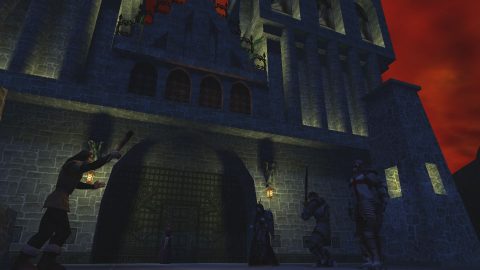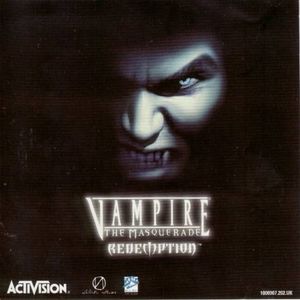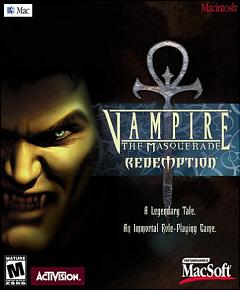- Vampire: The Masquerade (Introduction)
- Vampire: The Masquerade – Redemption
- Vampire: The Masquerade – Bloodlines
After the brief summary offered about the setting, you might think that only a Western RPG cleverly mixing choices and political intrigue can be true to Rein-Hagen’s lovechild. Nihilistic Software, for their first game, thought otherwise or maybe they didn’t have a choice. Anyway, they turned the setting into an heavily story-driven hack’n slash. While that might sound blasphemous to pen-and-paper RPG fans, the game is actually quite enjoyable for many reasons.
The game puts you in the shoes of Christof Romuald, a young Knight of the Order of Saint-Jean, sent to retake the Holy Land. Unfortunately, during his travels through Czechoslovakia, Christof is severely wounded and ends up waking in a Prague Monastery. During his recovery, our hero falls in love with one of the local nurses, Anezka. In the meantime, he is commanded by the local bishop to cleanse the silver mines of a dwelling evil. During this task, Christof stumbles upon animal ghouls and their Tzimisce master. Slaying this strong Kindred is no small feat, thus catching the eye of Ecaterina the Wise, the local Brujah leader. To avoid Tzimisce payback and to acquire a powerful pawn, she embraces the poor heart-stricken crusader. After proving his worth to his sire, Christof reveals his true nature to Anezka, making the young nun begin her own quest to free her beloved from vampirism. Things go from bad to worse when Anezka gets captured by Tzimisce, forcing Christof and his many allies to hunt her down through Eastern Europe.
Characters
Christof Romuald
A French crusader (“Christophe” is the correct spelling but wasn’t used because it sounded too odd) seeking his long lost love Anezka. He is brash and doesn’t really care about Kindred etiquette, which gets him in a lot of trouble. An honorable warrior, his stats can be tailored to your liking. He automatically gains a new discipline tree at the end of each dungeon.
Whilhem Streicher
A German Brujah Ancillae who acts as Christof’s big brother, showing him the ropes of medieval unlife. He has a snarky demeanor and a very laid back attitude. While Brujah is like the protagonist, he also starts with the awesome Protean skill and can quickly grow into a powerhouse. A very versatile character to the end and probably the best companion in the game.
Serena
A Cappadocian neonate who joins the crew after unmasking a conspiracy within Praguian cell. Acting like a typical goth, she is very pale (Cappadocius’ curse) and has a very annoying voice. Starting with high mental stats, she is better used as a caster as she accesses strong disciplines like Mortis or Thaumaturgy.
Erik
A brutish Scottish gangrel with a strong sense of loyalty. You free him from the pits of a Tremere Chantry. Since you saved him from a fate worse than death (being turned into a gargoyle, a Tremere-bound bloodline), he owns a life debt to Christof. Not very smart, Erik starts with a ridiculous strength, which balances his late arrival to the party.
After the first fifteen hours (it’s a long game) of Redemption, Christof is finally reunited with his mortal love but things get even worse. Anezka had been turned into the ghoul of a crazy Tzimisce Methusalem who is about to rise from torpor. Rocks fall and everyone dies… or so it seems. Our undead hero wakes up in the headquarters of the Order of Leopold, the remnants of the Inquisition, in London five hundred years later. Lost in this brand new world, the Crusader will have to gain new allies to slay the nefarious Methusalem and take back Anezka.
The two epochs offer far cry atmospheres from each other. Equipment and character appearance obviously change but Nihilistic went a bit further than that. Your user interface itself becomes entangled in cobwebs and painted with graffiti. A different composer took on the modern part of the game adding techno and rap vibes to the soundtrack. The result isn’t stellar. On the other hand, the medieval soundtrack is one of the finest soundtracks made for a roleplaying game. Kevin Manthei (Sacrifice) perfectly transposes feelings of despair and dreariness.
Redemption is extremely linear and revolves exclusively around one huge plot and no sidequests at all. From time to time, picking up dialogs choice is allowed but doesn’t change much apart from influencing your humanity pool. Dialogue is ubiquitous and conveys a dense backstory. Every time you stumble upon a new place or encounter a new clan, your party will start chatting to explain to you another subtle detail of the setting. Strangely enough, while the form (a Diablo-like) is an aberration to V:TM, the game explains extremely well the setting and even shows some subtlety about it (the opposition Sabbat/Camarilla for example). Even if the love story is a bit heavy, the script is really well done, with colorful characters, dramatic twists and quite a bit of humor. The voice-acting is so-so, sometimes good (Ecaterina), sometimes atrocious (Christof’s accent).
White Wolf actually invested substantially in this game, as writers of several source books are involved, and Patrice Lambert, one of the numerous illustrators of White Wolf now working for Ubisoft Montreal, contributed the concept art. The manual of the game is a lite version of the rulebook of the 3rd edition of Vampire: The Masquerade, giving you a page of information on every clan (even the absent Ravnos), proper introduction to the setting and a novella featuring Christof’s younger years. Christof is credited in the Who’s Who’s of the 3rd edition Brujah source book as a cross-marketing tactic. On a more trivial note, the game winks at the Vampire connoisseur by using known NPCs such as Ecaterina the Wise or Detritus of the Inner Council.
Redemption plays and feels exactly like Diablo. You click, you kill enemies, get loot and experience. The equipment each character can equip is restricted by their stats. Level design is exactly the same too – a hub with merchants, linked to various dungeons. Early dungeon design is atrocious with dark mines and overpowered bosses. It gets better later on and even reach an apex later on with a clever gimmick. Nothing new under the sun (or the moon?). Fortunately, there is more.
Each one of your characters have three pools: life, frenzy and blood. Normally, only life and blood pools are full. When you start taking damage, your life depletes and your frenzy fills a little and healing depletes blood. The tricky thing is the less blood (or life) you have, the faster the frenzy pool rises. When it’s full, the beast takes over your character and the character goes nuts, feeding on the closest character (including yours), going berserk or fleeing. Managing your various pools is probably the most important aspect of the game, since frenzy can create a total-party-kill fast. When your characters deplete completely their life bar, they fall in torpor but can still be raised via specific disciplines. However if they are all in torpor, the game is over.
Despite being taking place during the dark of night, Redemption‘s graphics are vivid and display an impressive work on textures for the times. Clever lighting work recreates the torch-lit cities of Prague and Vienna. The animations are impressive as characters snatch each other or literally turn to dust. The pathfinding is terrible and AI companions often make very dumb moves. Don’t use the aggressive stance, ever. At the center of your interface, 3D heads of your party give you direct feedback of the situation – watch them change armor, feed or go into frenzy. The character models themselves have aged badly though, and appear extremely blocky.
Disciplines are extremely well done and fun to use. Like everything in Redemption, they are mostly the same as in the PnP but have been adapted for practical issues. Their range is extremely wide – invisibility, raising dead enemies, growing sharp claws, making blood boil, and so forth. While some are overpowered, the game is never difficult enough that it forces you to use them, so you’re free to experiment. Having four characters in your party can also help in that matter. That is probably one of the best aspects of the game – finding the disciplines you like and abusing them. Most disciplines offer successively unlockable powers for variety’s sake.
Due to the importance of blood, feeding is another key element. It can be done on almost every humanoid character through a simple right-click. For obvious reasons, armored enemies and non-humanoids are out of the question. Completely draining an innocent bystander makes your character loses humanity. If you ever reach zero at any moment, it’s an immediate game over. This moral counter also determines the ending you get. Last but not least, guards and cops roam around the cities hub and will attack you on sight. If your “feeding” skill is high enough, you can grab any Kindred and drain him to death. While that sounds like overkill, the process is slow and leaves your character defenseless. Party members can also share blood between them. You can equip a gorget to avoid getting drained by enemy vampires too. Blood packs can also be bought for dire situations.
While the equipment is classic, weapons are divided in three specific categories related to the original pen and paper game. Bashing weapons (fists, maces) don’t do much damage, lethal (swords and guns) weapons are the most common type, and aggravate weapons (fire, disciplines) are rare and hurt substantially. The panel of weapons is quite large (polearms, swords, guns, explosive) and offer some exotic examples such as a stake-launcher. Still, it’s a bit sad for a game focused so much on a Diablo-like experience to give players such a bland loot. With a few exceptions, magical items are lackluster and the best equipment has to be bought from merchants.
Maybe the strangest feature of Redemption is its multiplayer. In a nutshell, it was supposed to mimic a conventional roleplaying game, a year before Neverwinter Nights. You can create a character (human/ghoul/vampire), select your clan and spend your starting experience points. The host of the game thereby becomes the game master and can influence anything in the game: spawn items/monsters, control a character, grant experience. Two official chronicles are available from the get-go, but if a GM wants to create his own story, he is in for a ride. Indeed, Redemption uses a JAVA-like scripting editor. So even if the SDK was released, it’s fairly understandable that not many people were willing to learn it to create awesome multiplayer chronicles.
Nihilistic’s approach was polarizing, to say the very least. On one hand, they adapted as best they could Vampire‘s mechanics to Diablo-like core gameplay. This has been done well, but on the other hand, every aficionado will scream at that particular choice of genre. In a world of “personal-horror” and byzantine power games, you spend your time genociding the vampiric population of Prague, Vienna and later on London and New York. Besides, while all the setting is explained and directed extremely well, some basics rules of V:TM are butchered. Draining a vampire without Diablerie? It’s cool. Feeding on my buddies every two minutes without blood bond? Yup. Even without being too regarding on this, Redemption remains a real paradox – to enjoy it, you must accept that you are playing first and foremost a Diablo-like which looks like a Vampire The Masquerade adaptation. But at the same time, its driving force dwells in the setting and the atmosphere, not the hack and slash mechanics.
In retrospect, Redemption suffers greatly when being compared to Bloodlines, which was released three years later. It’s obvious that the games tackle very different approaches but adaptations crave for comparison and a hack-n-slash opposed to a real RPG made by the makers of Fallout is going to be crucified by the fans.
Links:
Gamasutra’s Post Mortem Robert Huebner (Nihilistic’s former CEO) comes back on the development of the game.
WOD Mod One of the biggest mods created for the game and one of the last websites dedicated to Redemption to be still up.





